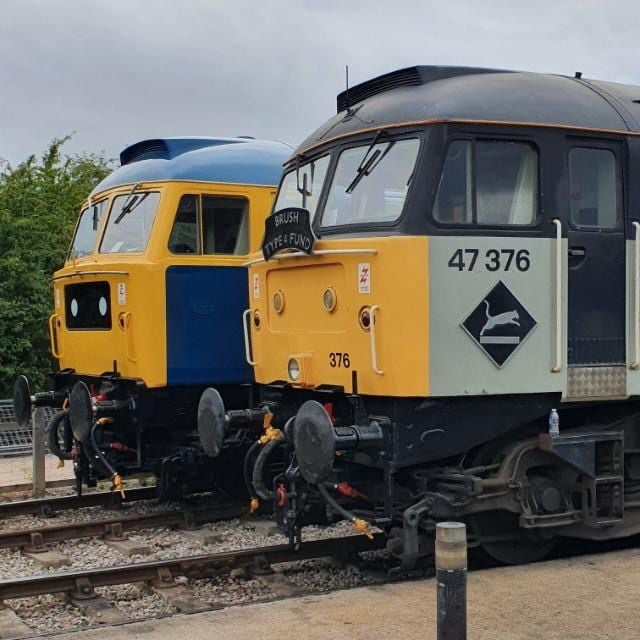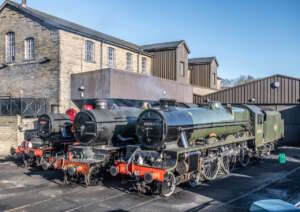The Gloucestershire Warwickshire Railway has announced that its trains will be ‘doubling up’ on 7 May, 6 August and 3 September.
They will be double-heading and ‘top ‘n’ tailing’ train services, giving visitors and diesel enthusiasts the full ‘Brush’ and ‘English Electric’ experience on these summer Sundays. They will operate in these pairs:
- GWR’s resident Brush Type 4 (British Rail Class 47) Co-Co diesel-electric locomotives Nos 47105 and 47376
- English Electric Type 3 (British Rail Class 37) diesel-electric locomotives Nos D6948 and 37215
Five hundred and twelve Brush Type 4 / British Rail Class 47 locomotives were built between 1962 and 1968, with construction carried out at Brush Traction’s Falcon Works in Loughborough and British Railways’ Crewe Works. With the decline of steam, and with diesel-hydraulics falling out of favour (having become synonymous with the Western Region), the Class 47s quickly became the workhorse of the new diesel-electric era.
The Brush Type 4s are fitted with powerful 2,750-brake-horsepower Sulzer 12LDA28-C engines (which were later de-rated to 2,580 bhp to aid reliability), and could be found operating both freight and passenger services across the railway network.
Many of the class took charge of express passenger workings which had previously been the preserve of prestigious steam locomotives. The locos had a route availability of 6 and 7 (RA6/7) and many had colourful and interesting careers wearing a myriad of liveries.
Subclasses were developed to meet the changing needs of British Rail and the privatisation era which followed in the mid-1990s. Between 1998 and 2004, Brush Traction rebuilt thirty-three locos, fitting them with EMD 12-645 engines and reconditioned alternators, which became the British Rail Class 57s.
Class 47 proved popular with rail operators and enthusiasts alike, and over seventy still exist, some in active mainline service, others in long-term storage or in preservation.
The Gloucestershire Warwickshire Railway currently has two members of the class in its home fleet which are both permanent residents.
- 47105 (D1693) was built by Brush Electrical Machines Ltd at Loughborough in 1963. The loco was accepted into traffic on 6 December 1963 as D1693 and operated for nearly thirty years before being stored as unserviceable on 1 November 1993. It was withdrawn from service on 13 December 1993 and was bought by the Brush Type 4 Fund on 24 January 1994. The locomotive was transported to the GWR in April 1994 and started for the first time in preservation one month later. Since then, a large amount of work has been carried out on the 47, including the reinstatement of its steam heat boiler, making 47105 the first Class 47 to steam since 1987. The loco returned to passenger service on 16 July 2021 after a ten-year overhaul, including a full repaint into British Rail Blue livery.

- 47376 (D1895) was built by Brush Electrical Machines Ltd at Loughborough in 1965 and accepted into traffic on 1 September 1965 as D1895. It operated for nearly thrity-six years before its last working on 8 June 2001. Whilst operating the Southampton freightliner (4O07) in the Oxford area, a piston dropped into the engine sump, writing off the Sulzer 12LDA28-C engine, with the train assisted to Southampton by a Class 57. The Class 47 was purchased by The Brush Type 4 Fund in November 2002 and transported to the GWR in 2003 after receiving a replacement engine at Ashchurch from sister loco No. 47295. The engine swap took place on 21 June 2003 following 47376’s arrival from Southampton Maritime. 47376 was the first locomotive to wear the Freightliner Triple Grey livery.
English Election built three hundred and nine English Electric Type 3 / British Rail Class 37 locomotives between 1960 and 1965, with construction carried out at Vulcan Foundry in Newton-le-Willows and Robert Stephenson & Hawthorns in Darlington. The Class 37s were versatile and reliable locomotives which made light work of heavy freight trains and mainline passenger services on both primary and secondary routes.
The locos had a low axle load and a route availability of 5 (RA5), meaning that they could travel nearly anywhere on the national railway network, making them particularly useful for operating services on branch lines. Their reliability led to the development of subclasses designed to extend their lifespan. Over ninety of the locomotives exist today, some in active mainline service, others in long-term storage or in preservation. Much like the Class 47s, the Class 37s have a big following with rail enthusiasts and are known to many as ‘Tractors’ because they sound quite similar to the agricultural vehicles!
The Gloucestershire Warwickshire Railway currently has two members of the class in its home fleet which are both permanent residents.
- 37215 (D6915) is a 37/0 owned by The Growler Group and was built at Newton-le-Willows in 1963. The loco operated for nearly twenty-nine years before being taken out of service in 1992. The Type 3 was preserved in 1994 and arrived at Toddington that summer. It was restored to full working order in 1998, and this year reached the milestone of twenty-five years of active preservation service. In 2007, 37215 was repainted in to a high standard in BR blue livery as worn by the class during the 1970s and 1980s.
- D6948 (37248) is a 37/0 owned by four individuals who are members of The Growler Group. The loco, built at Newton-le-Willows in 1964, came to Toddington in 2010 wearing West Coast Railways livery and carrying its TOPS running number of 37248, having been restored to operational condition at Carnforth by West Coast Railways as part of a loan agreement which expired in 2009). Under preservation, the Type 3 underwent refurbishment over several years to restore it to its original condition. This included the provision of steam heating and a return to BR green livery with small yellow warning panels (GSYP). Having spent the past three years out of service, the locomotive returned to active service earlier this year, and will return to a Diesel Gala for the first time since summer 2019.
The sound of a 2,580 bhp Sulzer 12LDA28-C or a 1,750 bhp English Electric 12CSVT diesel engine rumbling through Greet Tunnel is hard to beat, especially when there are two of them at work!
Tickets for ‘Double Up Sundays’ are available to purchase here.






Responses